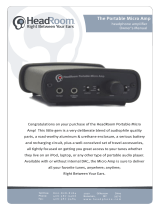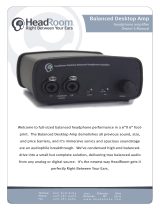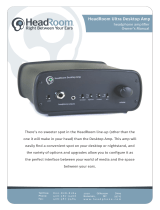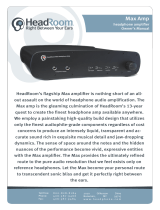Page is loading ...

1
Portable Desktop Amp
headphone amplifier
Owner’s Manual
Toll Free: 8 0 0 - 8 2 8 - 8 1 8 4
Phone: 4 0 6 - 5 8 7 - 9 4 6 6
Fax: 4 0 6 - 5 8 7 - 9 4 8 4
2020 Gilkerson Drive
Bozeman, MT 59715
w w w . h e a d p h o n e . c o m
Congratulations on the arrival of your new Portable Desktop Amp.
The slender and curvaceous amp you now hold in your hands is the
most current result of a 15 year long quest to build the world’s fin-
est portable headphone amplifier. It’s equally comfortable in your
big rig at home or on the tray table in front of you at 30,000 feet. It
will take an analog or digital input from a $10,000 cd player, laptop,
or iPod, and drive your high quality headphones with authority
and aplomb. It’s a little slice of your big rig you can take with you
anywhere you roam; an Audiophile’s movable feast. And now it’s
yours! Thank you, we’re so happy to help you get it right between
your ears.

2
3
The Desktop Portable Amp
2.
Headphone
Outputs
1.
Power
Switch
3.
Input
selector
Switch
6.
Volume
Control
4.
Crossfeed
Switch
5.
Gain
Switch
1. Power Switch When the power is set to ‘on’; the green LED will illumi-
nate in the center of the HeadRoom logo in the upper left hand corner of the
amp. We recommend turning the amp off when not in use to avoid draining
the batteries.
2. Headphone Outputs The headphone out is where you plug in your
headphones. The Portable Desktop Amp is equipped with a 1/4” jack as well
as an 1/8” jack, to accomodate various types of headphones.
3. Input Selector Switch Choose between analog or digital inputs with
the flick of this switch.
4. Crossfeed Switch This switch engages the crossfeed circuit. Audio im-
aging on headphones is often not very good; typically the image is a blob on
the left, a blob on the right, and a blob in the middle. The HeadRoom cross-
feed provides the natural acoustic cross-feed normally heard at the left and
right ear as heard from the left and right speaker. Adding back the normally
occurring cross-feed signal gives your brain enough information to build the
stable and natural audio image needed to have a quality listening experience.
See pg. 7 for more info on the HeadRoom crossfeed.
5. Gain Switch The 3-position Gain Switch accomodates various head-
phones’ power needs. For instance, the Low Gain setting would be used for
ear canal headphones, allowing a larger range on the volume control pot. Ex-
periementing with your headphones and the gain switch may help you to de-
termine which setting you prefer. If have any questions regarding your head-
phones, feel free to call and ask us.
6. Volume Control As you turn the volume control knob clockwise, the
volume increases. You never know where the volume control should be set
as different headphones often have widely different impedances and effi-
ciencies, so use your ears to choose your listening level, not the level on the
dial. We recommend you choose a moderate level so as not to blow out your
ears; a general rule of thumb is to adjust the volume only one or two knotches
above ‘sounding too quiet’. It is important to turn the amp OFF or ALL THE
WAY DOWN before plugging in or unplugging your headphones to avoid short-
circuiting the amp.
The Portable Desktop Amp Front Panel Front Panel Descriptions

4
5
The Portable Desktop Amp Rear Panel
2.
3.
5.
4.
DAC
7.
Power
Input
Rear Panel Description
1. Analog Inputs These connections are in parallel and can only be used
one at a time!
Rear Panel & Electronics Module
see page 6
1. Analog Inputs
a. RCA inputs
b. 1/8” input
a. RCA Analog Inputs There is one set of RCA inputs on the back
of the Portable Desktop Amp. The analog inputs are where you will plug in
your non-digital source, such as a stationary or portable CD player.
b. 1/8” Analog Input The 1/8” input is a typical line input con-
nector. You can connect your analog source by using a mini-mini cable from
the line out (or headphone jack) of your source into this connector.
6. Pre-amp Output The Pre-Amp output on the rear of the Portable Desk-
top is an excellent way to provide a volume controlled output to your desktop
speakers. It can also be used as a second headphone jack (do not however,
use it as a third headphone jack! Only plug two pair of headphones into your
amp at any given time.)
7. Power Input Recharge the battery of your Portable Desktop by plugging
in the charging unit here. After approximately 3 hours, your battery should be
fully charged and ready to go. You may listen to the amplifier while it’s charg-
ing. The battery on your Portable Desktop will last anywhere from 15-20 hours
(if you’re using the DAC on your Portable Desktop, the battery life will be lower
versus using only the analog portion of your amp). The lithium-ion batteries
in the Portable Desktop will last approximately 300 charges, at which point
you will need to send your amp back to HeadRoom so new batteries can be
installed. The 2 year HeadRoom warranty (see pg.10) covers battery replace-
ment; if your battery fails after this point we will replace it for a small fee.
Please contact us for details.
6.
Pre-amp
Output
This little blue module contains all the electronics for a Desktop Headphone
Amp. There are two 4-layer circuit boards (one each for the left and right chan-
nel) that are connected with a series of header pins used to solder the module
to the main circuit board. It uses TI 2134 op-amps for the internal input buffer,
crossfeed, summer, and power amp voltage gain stage. The output current
amplifier is our version of the highly regarded
Diamond Buffer discrete transistor design by
Walt Jung. Resistors are 1% metal thin film,
and caps in the signal chain are polyphenyl-
enesulfide (poly film); these are MUCH higher
quality parts than you’d ever find in a typical
consumer electronics product.
The Home Electronics Module

6
7
What is the HeadRoom Crossfeed?
Imagine you are listening to a pair of speakers. If you turn off the left speaker,
both ears hear the sound from the right speaker. But because the left ear is
slight farther away than the right ear, it hears the speaker’s sound slightly
after the right ear; about 300 microSeconds. This time difference is called the
“inter-aural time difference” and it is the main thing your brain listens for in
order to tell where to place sound left-to-right.
But in headphones if you turn off the left channel, only the right ear hears the
sound. In headphones, if there is any sound that is only in the left channel, or
only in the right channel, then only that ear hears the sound. This is not natu-
ral, and you brain becomes fatigued trying to figure out where sound is com-
ing from when only one ear is hearing it. This tends to create an audio image
that is a blob on the left, blob on the right and a blob in the middle.
HeadRoom amplifiers cure the problem by allowing you to cross-feed a little
of the left and right channels across to each other through a short time de-
lay using the processor switch. The usefulness of the circuit varies depending
on what type of recording you are listening to; mono and binaural recordings
need no processor at all. Old studio recordings that have instruments panned
hard left or right, benefit greatly from the processor. Live and classical record-
ings miked from a distance benefit somewhat less, and can often be listened
to without the processor quite comfortably.
Plain
Headphones
With
HeadRoom
The crossfeed switch in Head-
Room amplifiers allow you to
cross-feed a little of the left and
right channels across to eacho-
ther through a short time delay.
The Digital-Analog Convertor
Far ear
hears
slight delay.
Near ear
hears
sound first.
30 degrees
off axis
Portable Desktop DAC
The Portable Desktop DAC is a clean, well-balanced, and natural sounding
converter. It uses the Cirrus Logic’s flagship CS4398 24bit/192kHz, 120dB dy-
namic range digital to analog converter. Coupled with extensive power supply
isolation and regulation this DAC will take virtually any digital source and turn
it into a quality listening experience.
The Portable Desktop DAC board uses the well regarded Burr-Brown 134 in
single packages; only metal thin film resistors and polyphenylenesulfide (poly
film) capacitors are used anywhere near the audio circuits. Three low-noise,
ultra-low dropout power supply regulators isolate the various digital, analog,
and mixed signal circuits.
2. Coaxial Input The coaxial input is your typical coaxial connector. We
recommend using a 75 ohm digital cable when using the coaxial input.
3. Digital Input Selector When using the DAC, the digital input selector
allows you to choose which digital input you would like to listen to.
4. USB Input The USB input gets its signal from a computer: laptop or desk-
top; PC, Mac, or Unix.
5. Optical Input The optical input is your typical Toslink connector. You get
this input signal from the optical output of your player. Not so many portable
audio players have optical outputs anymore , but many portable DVD players
and some hard disk drive players do. Of course, you can get this signal from
many pieces of home equipment.
4. USB Input
5.
Optical Input
3.
Digital Input
Selector
2.
Coaxial Input

8
9
How to Connect Your Portable Desktop Amp
How to Connect your Portable Desktop Amp
#2 To a home CD player or other Analog Sources via RCA outputs
#1 To a portable player via Headphone jack or line out.
If your source has RCA outputs, an RCA to RCA interconnect cable will connect the
Portable Desktop. Plug the RCA inputs into the back of the Portable Desktop Amp, and
connect the other end to the line output of your analog source. If your source only has
an 1/8in line out or a headphone jack, then go up to #1. If your CD player has digital
outputs, skip to the next page.
- Switch the Source Selector Switch to analog.
- Switch Analog Input Switch to unbalanced.
All hard drive & CD players provide a headphone jack.* An RCA to Mini Cable will al-
low you to connect the headphone jack/line out of your player into the RCA inputs on
the Portable Desktop and a mini to mini cable will allow you to connect to the mini
outputs on the Portable Desktop. Be sure to note that as always, red or ‘R’, designates
right channel on RCA inputs. On the front panel, switch the Source Selector Switch to
analog.
*Use line out if your player has it. Line out bypasses the player’s volume control completely; use
the amp’s instead.
RCA Inputs
Interconnect Cable
RCA Mini Cable
Headphone Jack
RCA
Inputs
RCA Outputs
#4 DAC Option: To your Computer or other digital source via USB,
coaxial, or optical output
The most convenient and common way to get a high quality signal out of your com-
puter or UMPC is with the USB output. (If you have optical or coaxial outputs on your
machine, then skip to the next section.) Simply plug a USB cable into your computer,
and plug the smaller end into the back of the amp. In most cases your computer will
instantly recognize the amplifi er, but you will need to restart your music management
program. If your computer does not recognize the device, restart; if it still is not rec-
ognized, you may need to go into your control panel/audio devices or system prefer-
ences/sound output and select ‘USB Audio Codec’ as your default audio device.
- Switch the Source Selector Switch to ‘digital’.
- Switch the Digital Input Selector Switch to‘USB’.
To A portable DVD player with Optical outputs:
Connecting to your Computer:
You will need an appropriate optical cable, visit headphone.com to purchase a cable.
Plug one end into your source and connect the other end into the appropriate input on
the back of the amp.
- Switch the Source Selector Switch to ‘digital’.
- Switch the Digital Input Selector Switch to ‘optical’.
USB Cable
USB
USB Input
Mini to RCA Cable
RCA Inputs
Most self-powered speakers have RCA inputs, in which case you will use a 1/8in mini
to RCA cable to attach to the Portable Desktop Amp. Attach the cable to the pre-amp
output on the rear of the Portable Desktop Amp. Plug the other end into the input of
your speakers.
#3 Using Self Powered Speakers with the Desktop Portable
pre-amp
output
optical Cable
Optical Input
mini optical
To A home CD player with Optical/Coaxial outputs:
You will need an appropriate coaxial or optical cable, visit headphone.com to purchase
a cable. Plug one end into your source and connect the other end into the appropriate
input on the back of the amp.
- Switch the Source Selector Switch to ‘digital’.
- Switch the Digital Input Selector Switch to ‘coaxial’ or ‘optical’.
Coaxial Cable
Coaxial Input
optical Cable
Optical Input
mini Input
Mini-Mini Cable
mini B
A

10
11
30 Day Guaranty & Warranty Info
Exchanges & Returns
HeadRoom 30 Day Guaranty
Unless specifically stated otherwise, all HeadRoom purchases come with a
30-day satisfaction guaranty in order to give you the opportunity to evaluate
your purchases. We’re happy to provide you with the opportunity to refund or
exchange your product, but to keep costs down we do have a few conditions.
Products must be returned to us within 30 days of the date you receive the
product. So make sure you try your purchase out right away! Products must be
in “as-new” condition. This means that they’re in pristine cosmetic condition,
functioning perfectly, and include ALL materials (plastic bags, warranty cards,
tie wraps, etc). In other words, please send products back exactly as you re-
ceived them. If a product is returned within the 30-day return period, but is not
in “as-new” condition, we will charge you a 15% restocking fee plus any labor
and materials required to return the product to “as-new” condition. Sorry, but
after your 30 day trial, products are no longer exchangeable or refundable.
If you’re having trouble with a headphone amp or system, please contact us
first to troubleshoot the problem. You can email Sales, (sales@headphone.
com) or call 800.828.8184. If we can fix it while you’ve still got the product,
everyone’s happy!
Portable Desktop Amp Warranty
The HeadRoom Portable Desktop Amp is warrantied for two years. If anytime
within the first two years of your purchase you have a problem with your amp,
you can return it for repairs under the terms of our warranty. HeadRoom is the
only authorized service center for HeadRoom products, either in or out of war-
ranty. If a unit is under warranty, there is no cost for the repair labor, parts, or
shipping from HeadRoom back to you (i.e., You’re responsible for paying the
shipping charges to get the product to us).
Out of Warranty Repairs
If you have an older HeadRoom amp that is out of warranty, call us at
800.828.8184 ext.104 or email [email protected]om to troubleshoot the
problem with our Service Department. Upgrades fees are calculated by labor
and parts costs. HeadRoom’s non-warranty repair rate is $100 per hour (billed
in 1/2 hour increments) plus parts. If the cost of the repair is over $100, we
will call you with an estimate. Repairs are conducted only on HeadRoom prod-
ucts. When we receive the equipment, we will initiate repairs and upgrades
within 1-2 weeks and return the unit to you. You are responsible for shipping
costs to and from HeadRoom for all non-warranty repair items.
Equipment Exchanges
If you would like to exchange your purchase for another item, you have two
options. You can simply purchase the item you want, and send the item you
don’t want back for refund within 30 days of the original purchase (don’t for-
get to fill out the back of the Return & Exchange card and include it with your
return). We will refund your credit card after we receive the item. Or, you can
send your product back as an exchange, and indicate the product you would
like on the Return card. We will adjust your credit card accordingly and ship
you the new item. Replacement products are shipped to you as soon as pos-
sible, typically within 3-5 days provided the replacement item is in stock.
Defective Equipment Exchanges
In the uncommon event of receiving a defective product, contact us and we
will ship out a replacement product to you at no cost as soon as possible,
typically within 3-5 days provided the replacement item is in stock. You will
receive the replacement item along with a return shipping label and a card to
include with the defective item to return to HeadRoom. Important: Fill in your
name and original invoice number of your order on the card and return the
item to HeadRoom within 2 weeks. If we have not received the product after 2
weeks (allowing shipping time) we will charge your credit card the amount of
the defective item. Please understand that we enforce this policy as an incen-
tive for customers to get defective equipment back to us as soon as possible.
Shipping Products back to HeadRoom
Please ship products back in the original shipping box (or another that is com-
parable); please don’t send headphones back in JUST the headphone box,
as it’s a sure bet that they will no longer be in “as-new” condition when we
receive them! We HIGHLY recommend that you ship returns using an insured
and “signature required” delivery method—we can’t be responsible for lost or
damaged packages. Finally, don’t forget to include the completed Return &
Exchange card and WRITE YOUR NAME on the outside of the box!
Return Products to:
HeadRoom
Attn: Returns
2020 Gilkerson Drive
Bozeman, MT 59715
Contact Us:
www.headphone.com
Toll Free: 800-828-8184
Phone: 406-587-9466
Fax: 406-586-9484

12
Toll Free: 8 0 0 - 8 2 8 - 8 1 8 4
Phone: 4 0 6 - 5 8 7 - 9 4 6 6
Fax: 4 0 6 - 5 8 7 - 9 4 8 4
2020 Gilkerson Drive
Bozeman, MT 59715
w w w . h e a d p h o n e . c o m
Contacting HeadRoom
A Word About Your Hearing
People have a natural tendency to listen to music at much louder levels with
headphones than they would with speakers. To avoid permanent hearing
damage, it’s important to be careful not to listen at extremely loud levels (or
to listen for too long at moderately loud levels). Because HeadRoom amps
need to be able to drive even the most inefficient dynamic headphones to sat-
isfactory listening levels, they are also able to drive headphones of average
or higher efficiencies to extremely high levels. As a result, even though the
volume control on your HeadRoom amp may appear to be set to a low level,
you may not be listening at a safe level. Generally speaking, when listening
to headphones you should only turn up the volume to the point at which the
sound isn’t too quiet.
As a general rule, sound pressure levels under 80 decibels will not damage
hearing, even if experienced continually. On the other hand, anything over
100 decibels may cause permanent damage very quickly. Sustained exposure
to sound pressure levels anywhere in between can also be damaging —the
louder the sound, the shorter the time required to cause permanent damage.
Just to drive this message home, here’s a bit of information about hearing
damage. The most common type of damage caused by prolonged or exces-
sively loud sound is called tinnitus. It manifests itself as a sustained buzzing
and/or ringing in the ears, and can become a permanent condition.
If you find that your ears are ringing or that there is a sensation of pressure or
fatigue, your body is trying to tell you that your ears need a break. Give them
a rest for a few days (or until they feel fresh). If you ignore these symptoms,
you’re risking permanent hearing damage.
In addition, don’t fool yourself into thinking that you either have full-blown
tinnitus or you don’t have it at all—there are different degrees of hearing dam-
age. For example, you might have a mild case where you only notice ringing
in your ears in the quiet of your bedroom at night. However, once you have a
slight case of tinnitus, your ears are much more susceptible to further dam-
age. So if you do experience mild symptoms, it’s important to be much more
careful about your exposure to loud sounds.
Sorry to sound so sobering, but a lifetime of musical enjoyment requires ears
in tiptop shape. Now that we’ve told you to be careful, don’t blame us if you
blow it. If you have any more questions about hearing damage, call a doctor.
/














